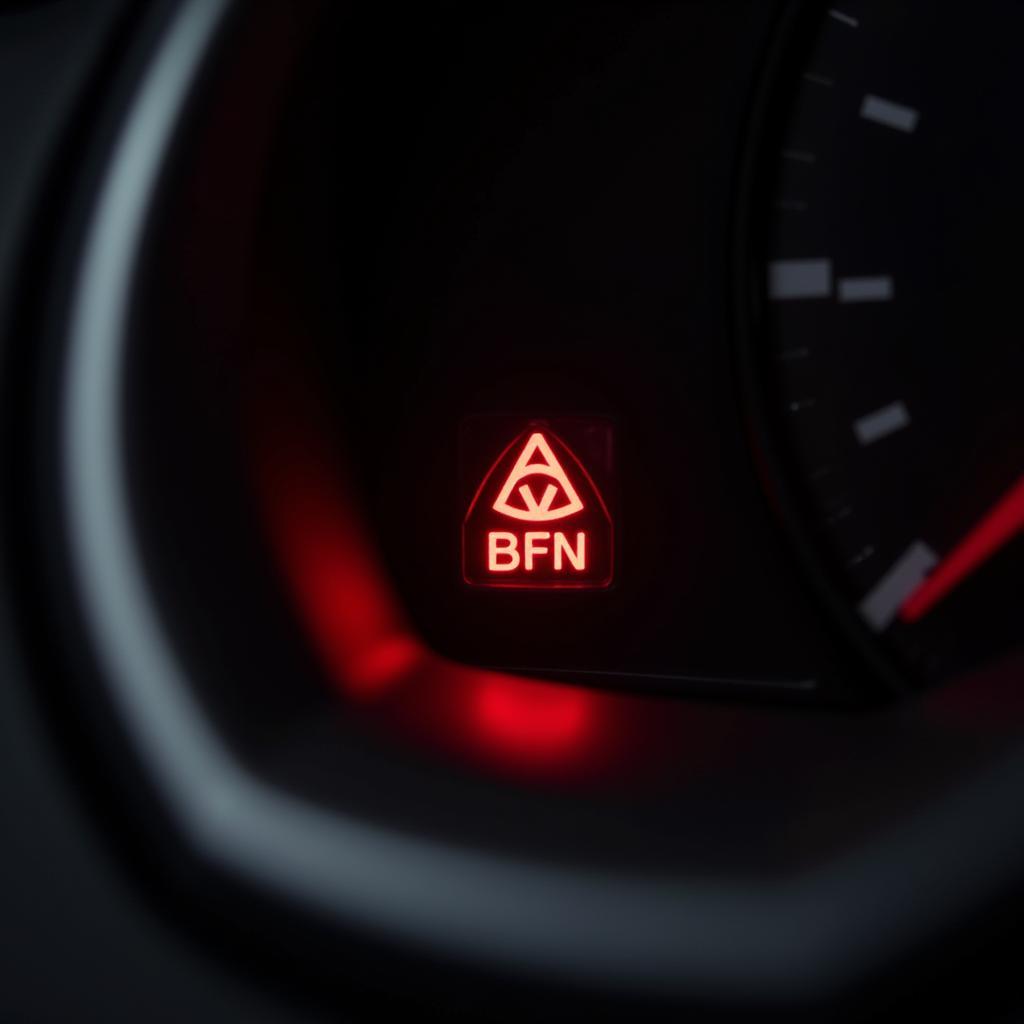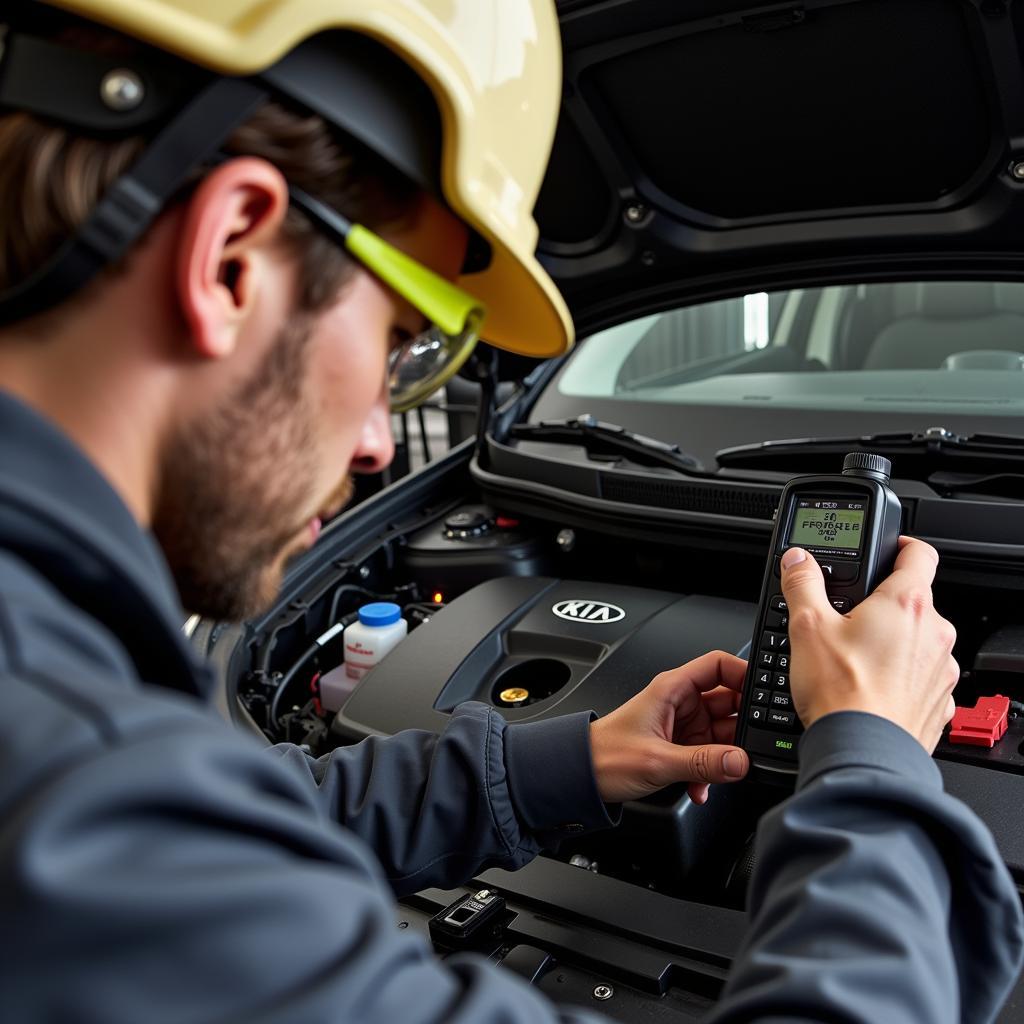The brake warning light on your Kia Sorento dashboard is a crucial safety feature designed to alert you of potential issues within the braking system. Ignoring this light could compromise your safety and lead to costly repairs. This comprehensive guide will help you understand the different reasons why your Kia Sorento brake warning light might be on, how to diagnose the problem, and the potential solutions available to you.
 Kia Sorento Brake Warning Light Dashboard
Kia Sorento Brake Warning Light Dashboard
Understanding Your Kia Sorento Brake Warning Light
The brake warning light, typically displayed as a red circle with an exclamation mark (!) or the word “BRAKE” in the center, can be triggered by various factors, ranging from a simple oversight to more serious mechanical failures.
Here are some of the most common reasons why your Kia Sorento brake warning light might be on:
- Engaged Parking Brake: This is the most frequent cause. Always ensure the parking brake is fully disengaged before driving.
- Low Brake Fluid Level: Brake fluid is essential for transmitting force to the brake pads when you press the brake pedal. A leak in the system or worn brake pads can cause the fluid level to drop, triggering the warning light.
- Worn Brake Pads: Brake pads have wear indicators that make a high-pitched squealing sound when they are nearing the end of their lifespan. If ignored, this can lead to the brake warning light illuminating.
- Faulty Brake Light Switch: The brake light switch activates your brake lights when you press the pedal. A malfunctioning switch can disrupt this signal and activate the warning light.
- ABS Issue: While less common, a problem with your Anti-lock Braking System (ABS), such as a faulty sensor, can also trigger the brake warning light.
Diagnosing the Problem
Determining the exact cause of the brake warning light requires a systematic approach:
- Check Your Parking Brake: Ensure it’s fully released. Sometimes, a slight bump can partially engage the brake.
- Inspect Brake Fluid Level: Locate the brake fluid reservoir under the hood. The reservoir will have a “min” and “max” marking. If the fluid level is below the “min” line, add the correct brake fluid specified in your Kia Sorento’s owner’s manual.
- Listen for Unusual Noises: When applying the brakes, listen for any grinding, squealing, or clicking sounds. These noises can indicate worn brake pads or other issues.
- Check Your Brake Lights: Ask someone to observe while you press the brake pedal to ensure all brake lights are functioning correctly.
 Checking Brake Fluid in Kia Sorento
Checking Brake Fluid in Kia Sorento
What to Do When Your Brake Warning Light Turns On
If the light turns on while driving:
- Stay Calm: Don’t panic. Pull over to a safe location as soon as possible.
- Assess the Situation: Determine if you can safely drive a short distance or if you require immediate roadside assistance.
Contact a Certified Mechanic:
It is strongly recommended that you take your Kia Sorento to a qualified mechanic, especially a Kia dealership or a trusted independent mechanic specializing in Kia vehicles, for a thorough inspection and diagnosis if:
- The brake warning light remains on after checking the parking brake and brake fluid level.
- You hear unusual noises when braking.
- You experience reduced braking performance or a spongy brake pedal feel.
- You suspect an issue with your ABS system.
Attempting to diagnose or repair brake system issues yourself can be dangerous and could lead to further damage.
Preventative Maintenance for a Safer Drive
Regular maintenance is crucial for a safe and reliable driving experience. Here are some preventative measures to help prevent brake warning light issues:
- Regular Brake Inspections: Have your brakes inspected by a qualified mechanic at least once a year or every 12,000 miles, whichever comes first.
- Timely Brake Pad Replacement: Adhere to the manufacturer’s recommended brake pad replacement schedule.
- Quality Brake Fluid: Use high-quality brake fluid and have it flushed and replaced according to your Kia Sorento’s maintenance schedule.
- Address Warning Signs Promptly: Never ignore unusual noises, vibrations, or changes in brake pedal feel.
Remote Diagnostics and Software Solutions
In some cases, the brake warning light in your Kia Sorento might be triggered by a software glitch or a sensor error. Advancements in automotive technology have paved the way for remote diagnostics and software solutions.
“With the increasing complexity of vehicle electronics, we are seeing more instances where a software update or recalibration can resolve issues related to warning lights, including brake system warnings,” says John Smith, Senior Kia Technician at XYZ Automotive.
If your Kia Sorento is equipped with telematics capabilities or you have an OBD-II scanner that allows for remote diagnostics, a qualified technician might be able to:
- Remotely diagnose the issue.
- Clear error codes.
- Perform software updates.
However, it’s crucial to note that not all brake warning light issues can be resolved remotely.
Conclusion
The brake warning light in your Kia Sorento is a critical safety feature that should never be ignored. While a simple issue like an engaged parking brake can trigger the light, it could also indicate a more serious problem requiring professional attention.
By understanding the potential causes, performing basic checks, and seeking timely assistance from a qualified mechanic, you can ensure your Kia Sorento remains safe and reliable on the road. Remember, when it comes to your safety and the safety of your passengers, it’s always best to err on the side of caution and consult a professional.
